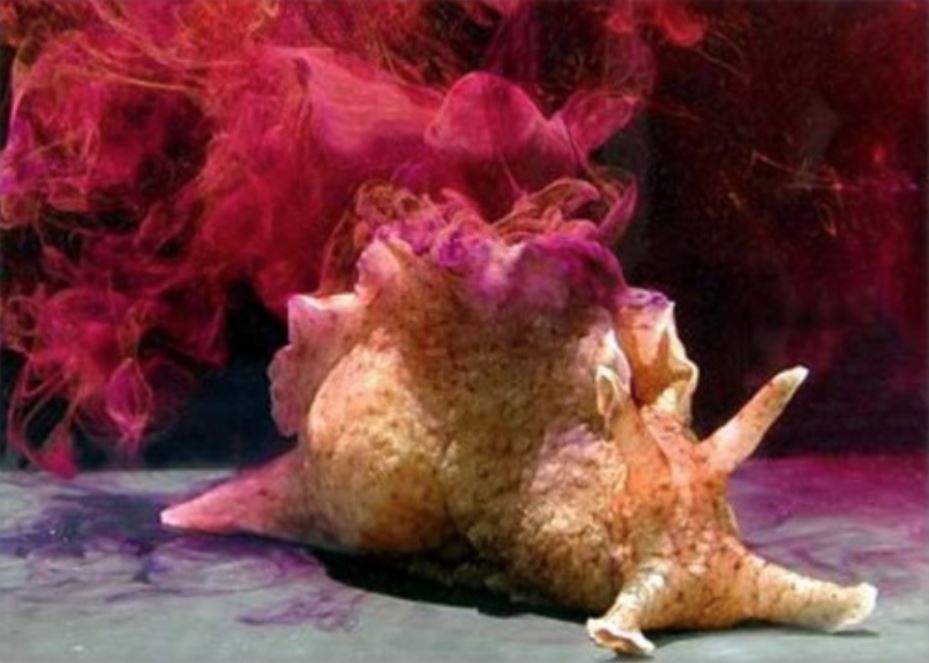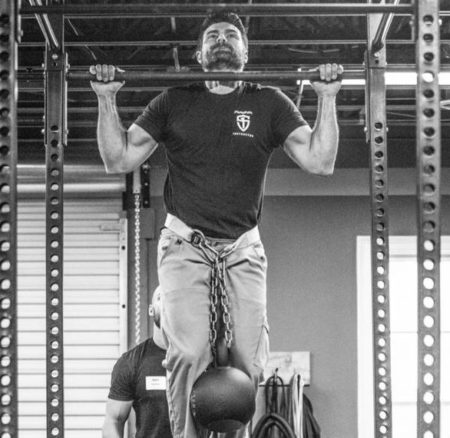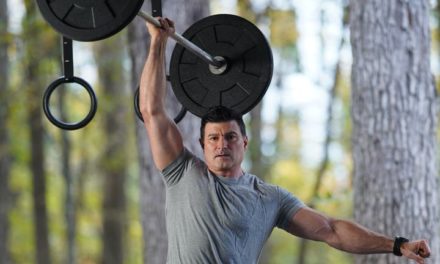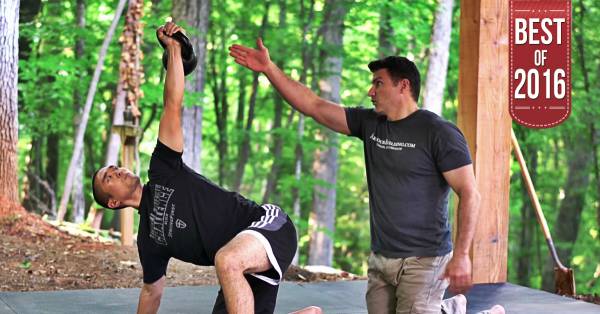The term “greasing the groove” (or GTG) is used frequently to describe the repetition of the same exercise frequently without going to muscular fatigue. In this article, we are going to take a deeper dive into the origins of the term, what happens in the brain and at the neuromuscular junction, and principles of this type of programming.
Specificity + frequent practice = success. It is so obvious, most people don’t get it. Once I came across a question posted on a popular powerlifting website by a young Marine: how should he train to be able to do more chin-ups? I was amused when I read the arcane and non-specific advice the trooper had received: straight-arm pull-downs, reverse curls, avoiding the negative part of the chin-up every third workout… I had a radical thought: if you want to get good at chin-ups, why not try to do… a lot of chin-ups? —Pavel Tsatsouline, 1999
Greasing the groove is a type of programming that builds the neurological pathway of lifting heavy weight. It does not rely on breaking down down muscle tissue for more growth, rather it uses your existing muscle structure by building new neural pathways. That is, it builds better wiring. Pavel, in his book Power to the People, described greasing the groove (GTG) as:
Muscle failure is more than unnecessary—it is counterproductive! Neuroscientists have known for half a century that if you stimulate a neural pathway, say the bench press groove, and the outcome is positive, future benching will be easier, thanks to the so-called Hebbian rule. The groove has been ‘greased’. Next time the same amount of mental effort will result in a heavier bench. This is training to success! The opposite is also true. If your body fails to perform your brain’s command, the groove will get ‘rusty’. You are pushing as hard as usual, but the muscles contract weaker than before! To paraphrase powerlifting champ Dr. Terry Todd, if you are training to failure, you are training to fail.
Mechanism behind Greasing the Groove
There are a few different mechanisms behind GTG. The first happens at the muscle and the second is neurological. At the neuromuscular junction, our neurons signal the muscle fibers to fire. Not all muscle fibers are used and we can squeeze out more strength if we learn how to recruit more fibers. To do this, we need more frequent firing from the neurons. We can train our neurons to fire more frequently by doing the movement more frequently.
The other component of this idea is that we use different muscles in our movements. In a press, our lat, tricep, stabilizers, and shoulder muscles all have to fire in a choreographed pattern to press the weight overhead. We need to coordinate these muscles to fire in a perfect symphony. Donald Hebb theorized that neurons wire together if they fire together. Thus, the more we do the movement the more we build the pattern of firing between muscles. If you perform the same movement perfectly and frequently, we build better wiring.

The other mechanism for greasing the groove is what happens in our brain. We have a primary motor cortex that initiates the signal down the spinal cord for the muscle to trigger. Other areas of our brain coordinate the movement before the signal is even sent down the spinal cord. If we can ‘practice’ the movement with our brain, we will get better at it. If we put people in an fMRI scanner and ask them to imagine doing an exercise, we see activation in the premotor cortex. The premotor cortex is where we visualize the movement before actually performing it. Years ago, Dr. Judd Biasiotto showed this relationship with basketball players. He had basketball players visualize a free throw multiple times before shooting. The mental practice improved their free throw shooting by 24 percent.
Dr. Biasiotto talks in the below excerpt about how he completed thousands of mental repetitions squats. Without lifting a single weight, he choreographed how each muscle moved prior to the squat.
Every one of the lifts I made during those initial training sessions was videotaped from three different angles. After each lift, the tapes were played back so Dr. Spieth and I could analyze my mistakes. Then, I would “mentally correct” each mistake. …Once he filmed me making the lifts with perfect form, we got Faye Reid, a Disney cartoonist, to replicate each frame of the film. … After they were completed, they were made into a loop so I could view them continuously with a loop-film projector. By viewing the film, I became aware of the muscles I was using during each segment of my lifts…I knew exactly which muscles to recruit and concentrate on to make the lift. The films also helped me to perfect my form. For example, it taught me the exact moment during my squat when I should kick my hips in and throw my shoulders back. In short, by using the films as a training aid, I learned to synchronize my mind with my body. … During the next two years of training, I must have reviewed those films at least 10,000 times.
Principles of Greasing the Groove
1. Train frequently
A true greasing the groove program would be similar to Pavel’s program that his father gave him as a child:
My father, a Soviet Army officer, had me follow an identical routine in my early testosterone years. My parents’ apartment had a built in storage space above the kitchen door (it is a Russian design, you wouldn’t understand). Every time I left the kitchen I would hang on to the ledge and crank out as many fingertip pull-ups as I could without struggle.
Training every day with multiple reps per day works really well for this type of programming. A set every hour works quite well.
2. Train with moderate to light weights
If you are training every day and frequently throughout the day, we cannot beat up the body and break down the muscles. We must be fresh throughout the day. You must never approach failure on any rep. Each rep should be performed almost to perfection (or at least as perfectly as you can make it). Use a lighter weight and do only a few reps at a time. If we are using pull-ups as an example, make sure that each one is crisp and that you are never struggling to finish a rep. You will need to adjust the weight based on your end goal. If your goal is to knock out 25 pull-ups, you will be doing many more reps at lighter weight (e.g., sets of 10). If your goal is to press your snatch weight 5 times with ease, you will find a weight that you can press with ease for 10 reps and practice it at 3 to 5 reps.
3. Train with medium to high volume
If you were to do a few reps every hour, every day, you would likely achieve quite a large volume of work. That is important in a greasing the groove program. We need a good amount of volume to allow the neuronal network to wire together.
An Example Program
Pull-ups are a great exercise for this program. There are many pull-up programs available, including Pavel’s example above as a teenager. Let me describe a press program for someone who is preparing for the high volume work of a SFG I or II. In my office, I hide a kettlebell near my desk. Every hour I press the kettlebell for a few reps. If I were training for my SFG I, I might use a kettlebell smaller than my snatch size (something I can press for 8 to 10 reps) and press that for 3 reps every hour. In an eight hour day, that would be 24 reps a day. With the lighter bell, it should not take a toll on the body and make you sore. If you are sore on the second day, go with a lighter bell. After a week or two, you presses should look feel and look better. Feel free to move up in weight as they get easier.
In the spirit of Plan Strong, I recommend waving the volume and the load. At random, have high, medium, and low volume days. You can adjust your timing to define volume. For example, a high volume day might be sets every 30 minutes for half the day. A low volume day might be sets every two hours. Intensity (or weight of the load) can be adjusted as well. Have a heavy day where you press the heavier kettlebell and a lighter day where you press the lighter one. Volume and intensity should not be coupled together. Randomly assign volume and intensity to your day.
It is never a bad idea to film your movements to see how they look. I tell my athletes to imagine that there is an Olympic sport where they rate your movements. Make each movement as close to a rating of 10 as possible. We are wiring our muscles for these movements, so we do not want to wire in sloppiness.
The final component to this program is to use Dr. Biasiotto’s obsessiveness with thinking about repetitions. As you fall asleep at night, imagine how each press feels. How the thighs, glutes, and abs get tight before each rep. Think about the press going up like a rocket and being pulled down by the lat. Imagine each muscle firing and get in a few hundred ‘thinking’ reps each day.
Summary
Greasing the groove has been used by many at StrongFirst. It fits with our principles of never going to failure and practicing in a perfect manner. By doing the movements once in a while in small bursts, we can devote the mental energy it takes to building perfect practice. It also teaches how tension builds strength. It is not the size of the muscle that matters as much as how well we utilize it. Greasing the groove develops the neural patterns needed for maximum strength.





